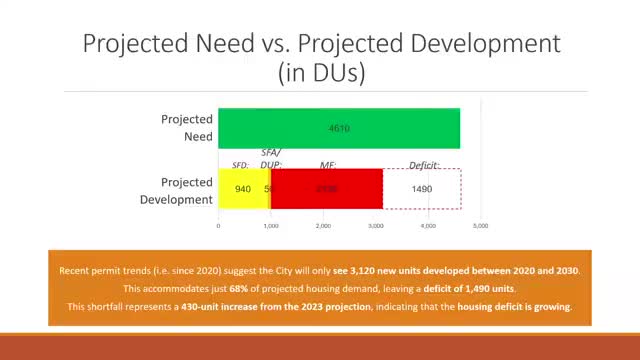Iowa City faces housing deficit of 1490 units amid population growth projections
June 06, 2025 | Iowa City, Johnson County, Iowa
This article was created by AI summarizing key points discussed. AI makes mistakes, so for full details and context, please refer to the video of the full meeting. Please report any errors so we can fix them. Report an error »

Iowa City officials are grappling with a growing housing deficit as the city anticipates a significant population increase over the next several years. During the recent Planning and Zoning Commission meeting, city planners revealed that Iowa City's population is projected to reach approximately 85,070 residents by 2030, marking an increase of about 10,240 residents since 2020. This surge in population is expected to create a demand for over 4,610 new dwelling units.
However, current permit trends indicate that the city is on track to only issue around 3,120 new units by 2030, which meets just 68% of the projected housing demand. This leaves a shortfall of 1,490 units, an increase of 430 units from last year’s estimates. The growing deficit raises concerns about housing affordability, as insufficient supply could lead to rising costs, making Iowa City less accessible for its residents.
The implications of this housing shortage extend beyond affordability. Planners noted that as housing development lags, nearby cities like Tiffin and North Liberty are experiencing rapid residential growth. This trend could lead to increased commuting distances and car dependency, ultimately impacting Iowa City's environmental goals.
To address these challenges, city officials emphasized the importance of promoting residential growth in areas with access to city services, particularly in designated growth areas and infill locations. As the city updates its comprehensive plan, these factors will be crucial in shaping future development strategies.
The discussions at the meeting highlight the urgent need for proactive measures to ensure that Iowa City can accommodate its growing population while maintaining affordability and sustainability for its residents.
However, current permit trends indicate that the city is on track to only issue around 3,120 new units by 2030, which meets just 68% of the projected housing demand. This leaves a shortfall of 1,490 units, an increase of 430 units from last year’s estimates. The growing deficit raises concerns about housing affordability, as insufficient supply could lead to rising costs, making Iowa City less accessible for its residents.
The implications of this housing shortage extend beyond affordability. Planners noted that as housing development lags, nearby cities like Tiffin and North Liberty are experiencing rapid residential growth. This trend could lead to increased commuting distances and car dependency, ultimately impacting Iowa City's environmental goals.
To address these challenges, city officials emphasized the importance of promoting residential growth in areas with access to city services, particularly in designated growth areas and infill locations. As the city updates its comprehensive plan, these factors will be crucial in shaping future development strategies.
The discussions at the meeting highlight the urgent need for proactive measures to ensure that Iowa City can accommodate its growing population while maintaining affordability and sustainability for its residents.
View full meeting
This article is based on a recent meeting—watch the full video and explore the complete transcript for deeper insights into the discussion.
View full meeting
